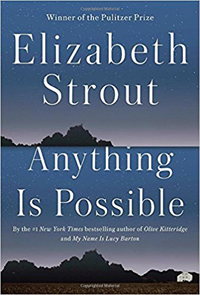 Elizabeth Strout, Anything is Possible (New York: Random House, 2017), 254pp.
Elizabeth Strout, Anything is Possible (New York: Random House, 2017), 254pp.
Elizabeth Strout's newest book is a sequel to her previous novel My Name is Lucy Barton (2016). In that book, Lucy Barton told about growing up in an impoverished and dysfunctional family in the tiny, rural town of Amgash, Illinois ("a run down town"), and then moving to New York City, where she became a writer. This book reverses course — Lucy travels back to Amgash after an absence of seventeen years.
As when her mother visited her in New York City, Lucy's return to her family roots is an occasion for small town gossip, reminiscence, re-connection, and deep introspection all around. The archaeology of family history is a delicate and complicated task. Memory plays tricks on you. People can parse a shared experience in different ways. All human love is imperfect.
The people in Amgash live small town lives, but in Strout's empathetic telling, they carry around big time hurts and questions. Like Tommy Guptill, now in his eighties, who spent thirty years as a school janitor after his family farm burned to the ground. Vets battling PTSD. A marriage that ends after fifty-one years. Childhood traumas. Aging parents. Troubled teenagers. Creepy voyeurs. Painful memories long buried. And sometimes, superficial niceties papering over it all.
Strout borders on the melodramatic, did we not see our own selves somewhere in this novel. She's always compassionate and never judgmental toward her characters. There are really no bad people here, just normal human beings trying as best they can to make sense of their difficult lives, to gain a modicum of understanding about things known and unknown, and so in the end hoping to find some degree of equanimity about "that most common complaint of all: Life had simply not been what she thought it would be."
Strout's book Olive Kitteridge won the 2009 Pulitzer Prize and sold over a million copies. For a brief overview of her life and work, see Ariel Levy, "A Long Homecoming: Elizabeth Strout's Small-Town Novels," The New Yorker, May 1, 2017.


